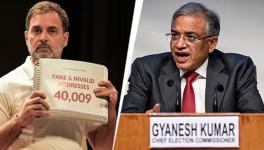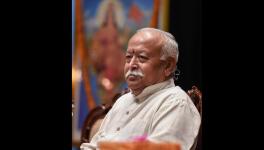Raja Narendra of Gujarat on the Wings of Intolerance
Narendra Modi is a big man. He does not seem his 62 years – energetic and brash, larger than life.
There is something in him of Bhima-parakrama, of terrible prowess. It is this edge that makes many uneasy with him. It also earns him the enthusiasm of those who favor Discipline above democracy.
The BJP, the party of the Right, sees the Indian parliamentary elections on the horizon and prepares to put forward its leading candidate for the polls. The old guard is now exhausted – Atal Bihari Vajpayee (born 1924) has lapsed into the fog of senility and L. K. Advani’s (born 1927) pasted smile no longer inspires the young. Those who are in Modi’s generation, born after Indian independence (1947), Arun Jaitley (born 1952) and Sushma Swaraj (born 1953) do not have the dynamism of Modi (born 1950). Jaitley, a student leader of the Right, has spent his career at the Bar and as the preeminent bureaucrat of the BJP. Swaraj began her political life as a socialist, having been raised in a hard Right family, but soon drifted toward her family’s political commitments. Often mentioned in the same breathe as Modi, neither Jaitley nor Swaraj have his mass capacity nor the machismo that is so essential for a party whose natural inclination is toward fascism.
The ruling coalition, the United Progressive Alliance (UPA), is directed by the Congress Party, the historic vehicle for India’s freedom movement that has now devolved into the main engine to deliver India to neo-liberal policies. In power since 2004, the UPA (now in its second term) is fixated on increasing India’s growth rate. Between 2004 and 2011, India’s growth rate averaged 8.3 percent, but it has fallen considerably since then (to 6.5 percent in 2011-12, and expected to drop to 5.4 percent in 2012-13). There is little actual expectation that the GDP will pick up. The IMF’s Article IV Consultation report for India (February 2013) argues that growth will not pick up unless the government tackles supply bottlenecks (particularly in mining and power), uncertainty about policies and lengthy delays in investment project approvals and implementation. On the question of delays, the IMF executives point to the coal sector (India has the fifth largest coal reserves in the world). Energy needs might be satisfied more efficiently if there were no “widening gap between coal production and demand,” but this gap is wide because of “regulatory delays (mainly environmental clearances).” Get rid of the environmental regulations, the IMF implies, and India will grow like gangbusters.
Nothing divides the UPA from the BJP on the question of reforms. The IMF’s Laura Papi and Rahul Anand recently wrote, “Stamina to carry out the reforms is required.” At the next election, it is either the UPA or the BJP that will come to power (the Left is too weak and the regional parties are all happy to line up behind one or the other of the bourgeois blocs). Neither will buck the IMF’s policy suggestions – they are only hampered by the demon of elections, where vote banks have to be guaranteed certain state benefits to cajole them to abandon one of the bourgeois blocs for the other. This is of course an irritant to the IMF wizards.
Modi has put himself forward as a better reformer for Indian capitalism than the current Prime Minister, Manmohan Singh. As Chief Minister of Gujarat, Modi claims to have created a miracle in his home state and wants this to be his resume for the PMship. Unfortunately for Modi, his history does not allow such subterfuge. Not only is Modi the putative leader of the BJP, but also he has been since his poorerprashadchildhood a member of the RSS, the moral center of Indian fascism. His rise to the top of the BJP came from both his loyal service to the RSS and his organizational work during the Ram Janambhoomi movement in the 1980s and 1990s, which culminated in the destruction of the 16th century Babri Masjid in Ayodhya and the anti-Muslim riots that came in its wake. Modi then returned to Gujarat as Chief Minister, where he oversaw the mass murder of over three thousand Muslims and the systematic disenfranchisement of Muslims and Christian tribals (in the Dangs district). Human Rights Watch’s April 2002 report, “We Have No Orders to Save You”: State Participation and Complicity in Communal Violence in Gujarat, should be compulsory reading for the Indian electorate.
Mention of the Gujarat killings rattles Modi’s supporters. They like to turn to the record of the Congress, which is no better. When you scratch a Modi supporter, out pours all manner of drivel about “Muslims” – birth rates are too high, they get all the advantages, damaged mosques are repaired with state funds, not damaged temples and onward. The BJP high command would like to bury this seam of anti-minority sentiment in the party. It excites the fanatics, but it terrifies the liberals. There is something indecent in this kind of talk. The high command would like to concentrate on two elements:
The Corrupt UPA government with its chair, Sonia Gandhi, as the principle target. There is no doubt that the Gandhi family has vacuumed more than its fair share of the social wealth into its bank accounts and its several properties. Her son, the dauphin of the Congress, Rahul Gandhi makes periodic trips to Dubai, they say, to make sure that the vaults are intact. No question that the Congress is vulnerable, as scam after scam unfolds. Little birds in Delhi tweet that Rahul Gandhi’s task is to maintain his family’s hold on power so that investigations of their personal corruption are not opened.
The torrent of social ills in the country, with the rapes and violence on the rise. The BJP’s sentimentality for Tradition leads it to make the case that far too much social laxity has enveloped India in a social crisis. From here come all manner of misogynistic and feudal statements about Indian Womanhood. It asserts, as most fascistic organizations do, that its brand of Discipline is the antidote to what has befallen India. There is no concern for the widening inequalities, a contributing factor to the social mayhem.
Against this record, the BJP would like to champion Modi as the Vikas Purush, the Development Leader. Modi would like this own Rath Yatra to travel directly from the industrial belt of Gujarat to Delhi with no detour through Ayodhya. Modi’s attempt to remake his image as a secular leader is threatened by the memory of the 2002 Gujarat pogrom and Modi’s own muscular commitments to the RSS. A weakened Congress would prefer Modi as its adversary than a more moderate BJP leader – as a caricature, Modi is easy to tackle.
Modi’s supposed probity is compromised by rumors of his own corrupt practices. When Wharton rescinded a speaking invitation to Modi, his prime backer Gautam Adani of the Adani Group withdrew his support to the Wharton India Economic Forum. Anti-corruption campaigner Arvind Kejriwal has accused Modi of corrupt deals with Adani, facilitating his access to easy licenses for his power plant, cheap land and cheap coal blocks. Modi and Adani deny the allegations. Once the flurry of the election season will open, more firm claims will emerge.
The bromides about the Gujarat miracle dissolve in the ether of the facts. My Frontline colleague, Lyla Bavadam, shows that in Gujarat the rate of growth of employment over the past twelve years has been zero, that between 40 and 50 percent of children are underweight and half of its children are malnourished, and that basic goods (fuel, food, clothing and housing) are among the more expensive in India. “Low employment, low wages, and high prices,” writes Bavadam, “the formula is one of despair.” To this “model” must be added Modi’s reactionary ideas about caste. In his Karamyog (2007), Modi writes that those castes fated to do sanitation work (clean gutters, sweep houses and cart away refuse), such as the Balmikis, do so as an “experience in spirituality.” “I do not believe that they have been doing this job just to sustain their livelihood,” says Modi, who anoints them to this despicable work because it is their “duty to work for the happiness of the entire society.” Subhash Gatade, who edits Sandhan, points out that when confronted by Modi’s logic a leading Dalit poet asked, “Why didn’t it occur to Modi that the spirituality involved in doing menial jobs hasn’t ever been experienced by the upper castes?” Old ideas of caste hierarchy mollified by spiritual balm, old ideas of growth corroded by social distress. Modi’s Gujarat models anomie, not hope. This is Gujarat as the world of voluptuousness and the world of woes.
Fortunately, Modi’s road to Delhi must go through 543 parliamentary seats. The BJP would have to win a majority of these seats before it can turn to its parliamentary leader to stake a case for the PMship. In the 2009 election, the BJP won 116 seats, with its coalition bringing in 159. The Congress won 206, with its UPA bloc winning 262. It would be a remarkable turn of events for the BJP to double its seat count, which is why it has to rely on regional parties; apart from one in the South (AIADMK) and one in the North (Akali Dal), the other regional parties are not comfortable with Modi’s corrosive history. The Congress is not an adversary and the corporate media has already begun to sing Modi’s praises. It is only this regional factor that might block Modi’s Juggernaut ride to Delhi.
Vijay Prashad’s new book, The Poorer Nations: A Possible History of the Global South, is out this month from Verso Books.
Disclaimer: The views expressed here are the author's personal views, and do not necessarily represent the views of Newsclick
Get the latest reports & analysis with people's perspective on Protests, movements & deep analytical videos, discussions of the current affairs in your Telegram app. Subscribe to NewsClick's Telegram channel & get Real-Time updates on stories, as they get published on our website.
























